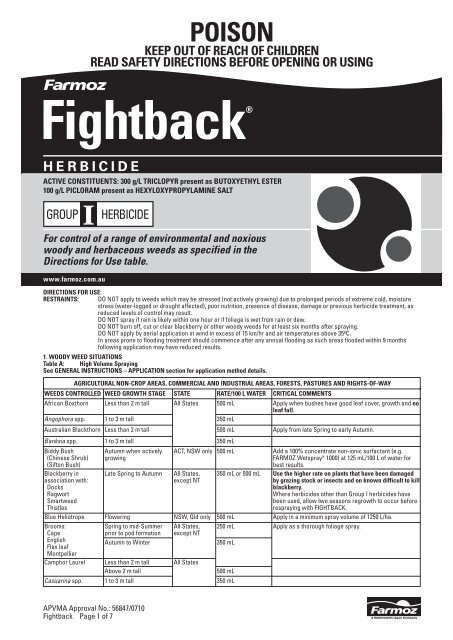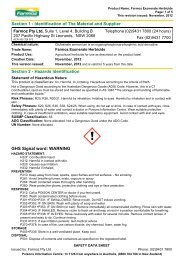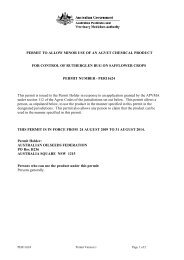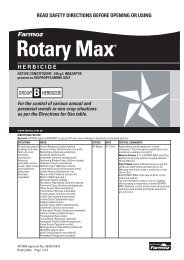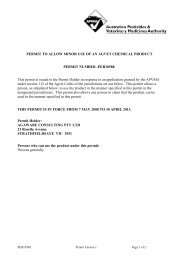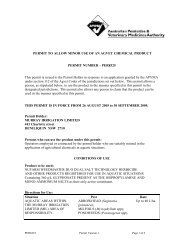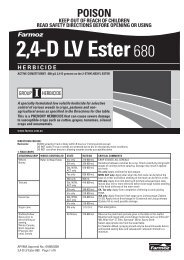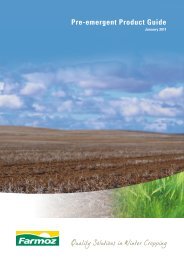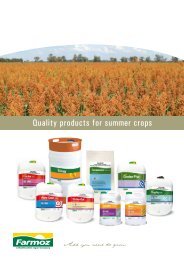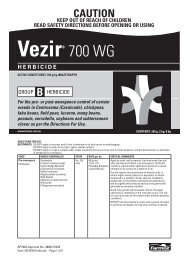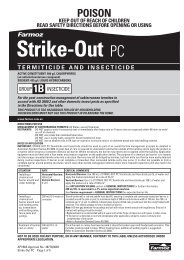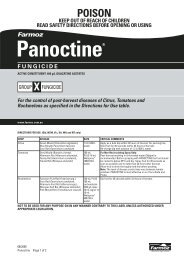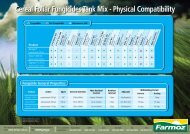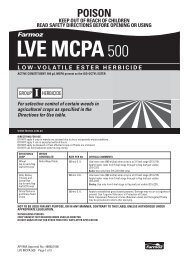You also want an ePaper? Increase the reach of your titles
YUMPU automatically turns print PDFs into web optimized ePapers that Google loves.
For control of a range of environmental and noxious<br />
woody and herbaceous weeds as specified in the<br />
Directions for Use table.<br />
www.farmoz.com.au<br />
DIRECTIONS FOR USE:<br />
RESTRAINTS: DO NOT apply to weeds which may be stressed (not actively growing) due to prolonged periods of extreme cold, moisture<br />
stress (water-logged or drought affected), poor nutrition, presence of disease, damage or previous herbicide treatment, as<br />
reduced levels of control may result.<br />
DO NOT spray if rain is likely within one hour or if foliage is wet from rain or dew.<br />
DO NOT burn off, cut or clear blackberry or other woody weeds for at least six months after spraying.<br />
DO NOT apply by aerial application in wind in excess of 15 km/hr and air temperatures above 35ºC.<br />
In areas prone to flooding treatment should commence after any annual flooding as such areas flooded within 9 months<br />
following application may have reduced results.<br />
1. WOODY WEED SITUATIONS<br />
Table A: High Volume Spraying<br />
See GENERAL INSTRUCTIONS – APPLICATION section for application method details.<br />
AGRICULTURAL NON-CROP AREAS, COMMERCIAL AND INDUSTRIAL AREAS, FORESTS, PASTURES AND RIGHTS-OF-WAY<br />
WEEDS CONTROLLED WEED GROWTH STAGE STATE RATE/100 L WATER CRITICAL COMMENTS<br />
African Boxthorn Less than 2 m tall All States 500 mL Apply when bushes have good leaf cover, growth and no<br />
leaf fall.<br />
Angophora spp. 1 to 3 m tall 350 mL<br />
Biddy Bush<br />
(Chinese Shrub)<br />
(Sifton Bush)<br />
Blackberry in<br />
association with:<br />
Docks<br />
Ragwort<br />
Smartweed<br />
Thistles<br />
POISON<br />
KEEP OUT OF REACH OF CHILDREN<br />
READ SAFETY DIRECTIONS BEFORE OPENING OR USING<br />
Fightback®<br />
HERBICIDE<br />
ACTIVE CONSTITUENTS: 300 g/L TRICLOPYR present as BUTOXYETHYL ESTER<br />
100 g/L PICLORAM present as HEXYLOXYPROPYLAMINE SALT<br />
GROUP I HERBICIDE<br />
Australian Blackthorn Less than 2 m tall 500 mL Apply from late Spring to early Autumn.<br />
Banksia spp. 1 to 3 m tall 350 mL<br />
Autumn when actively<br />
growing<br />
APVMA Approval No.: 56847/0710<br />
Fightback Page 1 of 7<br />
Late Spring to Autumn All States,<br />
except NT<br />
ACT, NSW only 500 mL Add a 100% concentrate non-ionic surfactant (e.g.<br />
FARMOZ Wetspray ® 1000) at 125 mL/100 L of water for<br />
best results.<br />
350 mL or 500 mL Use the higher rate on plants that have been damaged<br />
by grazing stock or insects and on known difficult to kill<br />
blackberry.<br />
Where herbicides other than Group I herbicides have<br />
been used, allow two seasons regrowth to occur before<br />
respraying with FIGHTBACK.<br />
Blue Heliotrope Flowering NSW, Qld only 500 mL Apply in a minimum spray volume of 1250 L/ha.<br />
Brooms:<br />
Spring to mid-Summer All States, 250 mL Apply as a thorough foliage spray.<br />
Cape<br />
prior to pod formation except NT<br />
English<br />
Flax leaf<br />
Montpellier<br />
Autumn to Winter 350 mL<br />
Camphor Laurel Less than 2 m tall All States<br />
Above 2 m tall 500 mL<br />
Casuarina spp. 1 to 3 m tall 350 mL
1. WOODY WEED SITUATIONS – Table A: High Volume Spraying – continued<br />
AGRICULTURAL NON-CROP AREAS, COMMERCIAL AND INDUSTRIAL AREAS, FORESTS, PASTURES AND RIGHTS-OF-WAY<br />
WEEDS CONTROLLED WEED GROWTH STAGE STATE RATE/100 L WATER CRITICAL COMMENTS<br />
Chinee Apple Less than 2 m tall Qld, WA only 350 mL Add a 100% concentrate non-ionic surfactant (eg.<br />
Wetspray 1000) at 100 mL/100 L of water for best results.<br />
Cockspur Thorn Spring to Autumn ACT, NSW,<br />
Qld only<br />
Common Sensitive<br />
Plant<br />
Gorse 1 to 1.5 m tall All States,<br />
except NT<br />
Grounsel Bush 1 to 1.5 m tall in<br />
(Baccharis halimifolia) Spring to Summer<br />
Over 1.5 m tall or<br />
Autumn treatment<br />
Green Cestrum Late Spring to<br />
early Autumn<br />
Lion Tail<br />
(Leonatis nepetifolia)<br />
Fightback Page 2 of 7<br />
All States,<br />
except NT<br />
ACT, NSW,<br />
Qld only<br />
250 mL Spring and Summer treatment only. Add a 100%<br />
concentrate non-ionic surfactant (eg. Wetspray 1000) at<br />
100 mL/100 L of water for best results.<br />
350 mL<br />
Add a 100% concentrate non-ionic surfactant (eg.<br />
Wetspray 1000) at 100 mL/100 L of water for best results.<br />
250 mL Apply as a thorough foliar spray.<br />
500 mL One application may give satisfactory control. Any<br />
subsequent regrowth and seedlings must be resprayed<br />
at approximately 1 metre high.<br />
Hawthorn Less than 2 m tall All States Apply from late Spring to early Autumn.<br />
Horehound Pre-flowering 350 mL<br />
Apply as a thorough foliar spray.<br />
Japanese Sunflower NSW, Qld only<br />
Lantana<br />
(Lantana camara)<br />
(Lantana<br />
montevidensis)<br />
Pre-flowering Qld only 200 mL Apply as a thorough foliar spray.<br />
Add a 100% concentrate non-ionic surfactant (eg.<br />
Wetspray 1000) at 100 mL/100 L of water for best results.<br />
Limebush Any time of year with<br />
good leaf cover and soil<br />
moisture<br />
NT, Qld only 350 mL Penetration of thick clumps may be difficult and<br />
respraying may be required.<br />
Addition of an adjuvant may improve results – contact<br />
FARMOZ Pty. Ltd. for details.<br />
Manuka At flowering Vic only 500 mL For optimum results, add Pulse* Penetrant at 200 mL/100<br />
L of spray.<br />
Thoroughly wet foliage, stems and soil around the base<br />
of the plants.<br />
Mesquite<br />
(Prosopis spp.)<br />
Any time when actively<br />
growing<br />
Eucalyptus spp. Seedling and regrowth<br />
from small lignotubers,<br />
1 to 3 m tall<br />
Galenia Fresh growth in<br />
Spring to Summer<br />
Over 1.5 m tall or<br />
Autumn treatment<br />
Winter treatment 500 mL Brownout may not be complete until Summer.<br />
Add a 100% concentrate non-ionic surfactant (eg.<br />
Wetspray 1000) at 100 mL/100 L of water for best results.<br />
Up to 1 m tall in<br />
Summer and Autumn<br />
1 to 2 m tall in<br />
Summer to Autumn<br />
Seedling, full leaf and<br />
flowering before podding<br />
NT, Qld,<br />
WA only<br />
Giant Bramble Spring to Autumn NT, Qld,<br />
WA only<br />
NSW, NT, Qld,<br />
WA only<br />
350 mL<br />
Prosopis velutina Qld only 670 mL<br />
Apply as a thorough foliage spray.<br />
200 mL To avoid leaves closing during application, spray plants<br />
while moving forward.<br />
Add a 100% concentrate non-ionic surfactant (eg.<br />
Wetspray 1000) at 100 mL/100 L of water for best results.<br />
Crofton Weed Spring to Autumn ACT, NSW,<br />
Qld only<br />
350 mL Apply as a thorough foliage spray.<br />
Eastern Cotton Bush Spring to Autumn NSW, Qld only 500 mL Add Uptake* Spraying Oil at 500 mL/100 L of water. Some<br />
(Maireana<br />
bushes may require a follow-up spray to control<br />
microphylla)<br />
regrowth.<br />
All States 350 mL or 500 mL Apply the high rate where difficult to control species of<br />
Eucalyptus regrowth is present.<br />
Addition of an adjuvant may improve results – contact<br />
FARMOZ Pty. Ltd. for details.<br />
NSW only 500 mL Use 2000 L of spray mixture/ha.<br />
Penetration of thick clumps may be difficult and<br />
respraying may be necessary.<br />
Add a 100% concentrate non-ionic surfactant (eg.<br />
Wetspray 1000) at 100 mL/100 L of water for best results.<br />
All States Add one of the following adjuvants, when using 350 mL<br />
rate:<br />
Uptake Spraying Oil @ 0.5% v/v.<br />
Pulse* Penetrant @ 0.1% v/v.<br />
500 or 750 mL Thoroughly wet foliage, stems and soil around the base<br />
of the plants. Use higher rate on known harder to kill<br />
varieties.<br />
350 mL DO NOT spray plants bearing pods.<br />
Add a 100% concentrate non-ionic surfactant (eg.<br />
Wetspray 1000) at 100 mL/100 L of water for best results.
1. WOODY WEED SITUATIONS – Table A: High Volume Spraying – continued<br />
AGRICULTURAL NON-CROP AREAS, COMMERCIAL AND INDUSTRIAL AREAS, FORESTS, PASTURES AND RIGHTS-OF-WAY<br />
WEEDS CONTROLLED WEED GROWTH STAGE STATE RATE/100 L WATER CRITICAL COMMENTS<br />
Mistflower Spring to Autumn ACT, NSW,<br />
Qld only<br />
350 mL Apply as a thorough foliar spray.<br />
Mother-of-millions Flowering NSW, Qld only 500 mL Add a 100% concentrate non-ionic surfactant (eg.<br />
Wetspray 1000) at 100 mL/100 L of water for best results.<br />
Paddy’s Lucerne Active growth NSW only Plants that have been continually slashed or grazed over<br />
many seasons may be difficult to control and regrowth<br />
may occur.<br />
Parkinsonia Under 2 m tall NT, Qld, WA<br />
only<br />
Rubber Vine<br />
(Not infected with<br />
rust)<br />
Fightback Page 3 of 7<br />
Up to 1.5 m tall at<br />
flowering<br />
NT, Qld,<br />
WA only<br />
St John’s Wort From flowering to early<br />
seed set<br />
Sweet Briar Up to 1.5 m tall All States,<br />
except NT<br />
Tobacco Weed Actively growing plants NT, Qld,<br />
WA only<br />
Wattle<br />
(Acacia spp.)<br />
(except Corkwood<br />
Wattle)<br />
Wild Rosemary<br />
(Cassinia laevis)<br />
Dense stands greater<br />
than 1.5 m tall at flowering<br />
1 to 3 m tall All States 350 mL<br />
Active growth,<br />
0.5 to 1.0 m tall<br />
Wild Tobacco Tree Spring to Autumn up to<br />
2 m tall<br />
350 mL Add Uptake Spraying Oil @ 500 mL/100 L water.<br />
Avoid spraying under dry conditions when plants are<br />
stressed or bearing pods. Thoroughly wet foliage.<br />
Prickly Pear (common) Active phyllode growth All States 500 mL Apply as a thorough foliage spray. Regrowth may occur,<br />
Smooth Tree Pear<br />
so a follow-up application may be necessary.<br />
350 mL Spray all leaves and stems just to the point of run-off and<br />
thoroughly spray the base of the plant. With larger, more<br />
500 mL<br />
dense stands, regrowth may occur.<br />
Subsequent control of any regrowth should be done by<br />
basal bark spraying.<br />
Siam Weed Active growth Qld, WA only 350 mL Add a 100% concentrate non-ionic surfactant (eg.<br />
Wetspray 1000) at 100 mL/100 L of water for best results.<br />
Sicklepod Up to flowering NT, Qld,<br />
WA only<br />
1. WOODY WEED SITUATIONS – continued<br />
Table B: Aerial Application<br />
All States 500 mL Late Spring to early Summer.<br />
350 mL Add metsulfuron-methyl at 10 g/100 L water to obtain<br />
more reliable results with the lower rate of FIGHTBACK.<br />
500 mL<br />
Full leaf to ripe fruit prior to leaf fall. Thorough wetting<br />
including the crown is recommended.<br />
300 mL Add a 100% concentrate non-ionic surfactant (eg.<br />
Wetspray 1000) at 100 mL/100 L of water for best results.<br />
Qld only 350 to 500 mL Use lower rate on seedlings 0.5 m tall. Apply as a<br />
thorough foliar spray.<br />
ACT, NSW,<br />
Qld only<br />
200 mL DO NOT apply to podding plants.<br />
Add a 100% concentrate non-ionic surfactant (eg.<br />
Wetspray 1000) at 100 mL/100 L of water for best results.<br />
350 mL<br />
AGRICULTURAL NON-CROP AREAS, COMMERCIAL AND INDUSTRIAL AREAS, FORESTS, PASTURES AND RIGHTS-OF-WAY<br />
WEEDS CONTROLLED WEED GROWTH STAGE STATE RATE/ha CRITICAL COMMENTS<br />
Blackberry Summer to Autumn NSW, Qld, SA, 10 L Where herbicides other than Group I herbicides have<br />
Vic, WA only<br />
been used, allow two seasons regrowth to occur before<br />
respraying with FIGHTBACK.<br />
WARNING: Eucalyptus species up to 4 m may be killed if<br />
sprayed during this treatment. Mature trees which are 15<br />
to 20 m tall may be partially defoliated but are likely to<br />
recover.<br />
Gorse Tas only Helicopter application only.<br />
Cockspur Thorn Late Autumn NSW, NT, 1.5 L plus<br />
Spray with calibrated equipment using the half overlap<br />
Crofton Weed<br />
Qld only 7.5 L 2,4-D Amine opposite pass technique applying a minimum spray<br />
Lantana<br />
(helicopter only) (500 g/L formulation) volume of 150 L/ha.<br />
Mistflower<br />
Follow-up respraying will be required.<br />
Lantana 10 L Helicopter application only.<br />
Rubber Vine<br />
When flowering NT, Qld only 3 L to 5 L Use rates will depend upon the density and height of the<br />
(Not infected with<br />
(helicopter only)<br />
rubber vine stand. The higher rate should be used on<br />
rust)<br />
dense stands, however, complete coverage and<br />
penetration may be difficult.<br />
Follow-up respraying will be required.<br />
Any regrowth should be sprayed with a suitable basal<br />
bark herbicide.
1. WOODY WEED SITUATIONS – Table B: Aerial Application – continued<br />
AGRICULTURAL NON-CROP AREAS, COMMERCIAL AND INDUSTRIAL AREAS, FORESTS, PASTURES AND RIGHTS-OF-WAY<br />
WEEDS CONTROLLED WEED GROWTH STAGE STATE RATE/ha CRITICAL COMMENTS<br />
St John’s Wort Flowering to early seed<br />
set (Nov-Jan)<br />
WEEDS CONTROLLED WEED GROWTH STAGE STATE RATE/ha CRITICAL COMMENTS<br />
Parkinsonia Seedlings 1-2 m tall, or 12- Qld, NT only 3 L Add Uptake Spraying Oil at 1 L/ha.<br />
24 months old<br />
(helicopter only)<br />
Fightback Page 4 of 7<br />
NSW only 4 L Helicopter application only. Follow-up spraying will be<br />
required in the following season.<br />
AGRICULTURAL NON-CROP AREAS ON FLOOD PLAINS.<br />
1. WOODY WEED SITUATIONS – continued<br />
Table C: Controlled Droplet Application (C.D.A.)<br />
See GENERAL INSTRUCTIONS – APPLICATION section for application method details.<br />
AGRICULTURAL NON-CROP AREAS, COMMERCIAL AND INDUSTRIAL AREAS, FORESTS, PASTURES AND RIGHTS-OF-WAY<br />
WEEDS CONTROLLED WEED GROWTH STAGE STATE RATE/ha CRITICAL COMMENTS<br />
Blackberry in Summer to Autumn All States, Apply undiluted One application may give satisfactory control but<br />
association with:<br />
except NT<br />
subsequent regrowth and seedlings should be re-<br />
Docks<br />
sprayed after hardening off. Where herbicides other<br />
Ragwort<br />
than Group I herbicides have been used, allow two<br />
St John’s Wort<br />
seasons regrowth to occur before respraying with<br />
Thistles<br />
FIGHTBACK.<br />
1. WOODY WEED SITUATIONS – continued<br />
Table D: Low Volume High Concentrate Application Techniques (Gas Powered Gun, Sprinkler Sprayer)<br />
See GENERAL INSTRUCTIONS – APPLICATION section for application method details.<br />
AGRICULTURAL NON-CROP AREAS, COMMERCIAL AND INDUSTRIAL AREAS, FORESTS, PASTURES AND RIGHTS-OF-WAY<br />
WEEDS CONTROLLED WEED GROWTH STAGE STATE RATE/ha CRITICAL COMMENTS<br />
Blackberry Late Spring to Autumn ACT, NSW, Qld, 335 mL Apply to actively growing bushes which are able to be<br />
SA, Tas,<br />
sprayed on all sides. For larger bushes, the high volume<br />
WA only<br />
application technique is recommended.<br />
Camphor Laurel Less than 1.5 m high ACT, NSW, 500 mL<br />
Cockspur Thorn<br />
Crofton Weed<br />
Qld only<br />
Eucalyptus species Seedlings up to 2 m tall All States 335 mL<br />
Mistflower Less than 1. 5 m high ACT, NSW,<br />
Qld only<br />
500 mL<br />
Sweet Briar 1.5 m tall, full leaf to<br />
ripe fruit<br />
St John’s Wort During flowering to early<br />
seed set<br />
NSW only Gas Powered Gun only: Apply to actively growing<br />
bushes not more than 1.5 m tall that have not more than<br />
5 stems from the crown.<br />
NSW, Tas,<br />
Vic only<br />
Wild Tobacco Tree Less than 1.5 m high ACT, NSW,<br />
Qld only<br />
1. WOODY WEED SITUATIONS – continued<br />
Table E: Boom Application<br />
See GENERAL INSTRUCTIONS – APPLICATION section for application method details.<br />
Gas Powered Gun only: One application should provide<br />
control. Minor regrowth and seedlings may be retreated<br />
the following Summer.<br />
Apply to actively growing bushes which are able to be<br />
sprayed on all sides. For larger bushes, the high volume<br />
application technique is recommended.<br />
AGRICULTURAL NON-CROP AREAS, COMMERCIAL AND INDUSTRIAL AREAS, PASTURES AND RIGHTS-OF-WAY<br />
WEEDS CONTROLLED WEED GROWTH STAGE STATE RATE/ha CRITICAL COMMENTS<br />
Galenia Fresh growth during NSW only 5 L Rough mine sites will require adequate spray equipment<br />
Spring to Summer<br />
such as boomless nozzles for effective coverage.<br />
Sicklepod Up to flowering NT, Qld only 3 L DO NOT apply to podding plants.<br />
Add a 100% concentrate non-ionic surfactant (eg.<br />
Wetspray 1000) at 100 mL/100 L of water for best results.<br />
St John’s Wort Flowering to early seed<br />
set (Nov-Jan)<br />
NSW only 2 to 4 L Use the higher rate on dense infestations and when<br />
longer residual control is required.<br />
Follow-up respraying will be required in the following<br />
season.
2. FALLOW SITUATIONS<br />
Table A: Boom Application<br />
See GENERAL INSTRUCTIONS – APPLICATION section for application method details.<br />
WEEDS CONTROLLED WEED GROWTH STAGE STATE<br />
FALLOW<br />
RATE/ha CRITICAL COMMENTS<br />
Blackberry Nightshade 10 to 25 cm tall,<br />
NSW, Qld only 200 to 400 mL +<br />
- suppression only prior to flowering<br />
1.2 L WIPE-OUT ® FOR USE BY GROUND EQUIPMENT ONLY.<br />
CT Plants must be actively growing.<br />
Herbicide + adjuvant Use the lower rate on the small weeds, as specified in<br />
the weed growth stage (or up to 5 cm diameter for<br />
Polymeria pusilla).<br />
Refer to WIPE-OUT CT label for use of adjuvant.<br />
DO NOT plant susceptible crops for up to nine months<br />
after application, as specified in General Instructions –<br />
Minimum Recropping Periods – Black Cracking Clay<br />
Soils, NNSW & Qld.<br />
Dry conditions after application will increase the<br />
recropping interval.<br />
Lucerne (established) Active growth, 15 to 25 cm<br />
300 to 500 mL +<br />
high, during Spring<br />
1.2 L WIPE-OUT ® CT<br />
Herbicide + adjuvant<br />
Polymeria pusilla 2 to 12 leaf up to 20 cm<br />
200 to 400 mL +<br />
diameter, prior to<br />
1.2 L WIPE-OUT<br />
flowering<br />
® Camel Melon<br />
Prickly Paddy Melon<br />
Cucumber Melon<br />
(Cucumis melo)<br />
From 2 leaf to 50 cm<br />
diameter<br />
Common Sowthistle<br />
Cow Vine<br />
From 8 leaf to flowering<br />
From 2 to 5 leaf up to<br />
15 cm diameter, prior to<br />
flowering<br />
CT<br />
Herbicide + adjuvant<br />
2. FALLOW SITUATIONS<br />
Table B: Blanket Wiper Application<br />
See GENERAL INSTRUCTIONS – APPLICATION section for application method details.<br />
WEEDS CONTROLLED WEED GROWTH STAGE STATE<br />
FALLOW<br />
RATE CRITICAL COMMENTS<br />
Bitterbark<br />
From Summer to end of Qld only 1:4<br />
For use with blanket wipers only.<br />
(Alstonia constricta) Autumn<br />
(1 part<br />
For best results apply in Autumn to tall (>60 cm) plants<br />
FIGHTBACK to using two opposite directional passes (up and back).<br />
4 parts water) Follow up “missed” plants with a spot spray application.<br />
These will be obvious after 6 weeks.<br />
Blanket wiper applications can be made in Summer<br />
when plants are smaller but follow up spot spraying may<br />
be necessary.<br />
DO NOT disturb (cultivate) the treated patches for at<br />
least 3 months. Best long term control is achieved when<br />
patches are left undisturbed for as long as possible after<br />
treatment (at least 6 months).<br />
2% solution for Spot spraying “missed” plants: Thoroughly wet all stems<br />
spot spray (eg. and leaves without producing any solution run-off. Avoid<br />
100 mL FIGHTBACK<br />
in 5 L water)<br />
any spray reaching the soil surface.<br />
NOT TO BE USED FOR ANY PURPOSE, OR IN ANY MANNER, CONTRARY TO THIS LABEL UNLESS AUTHORISED UNDER<br />
APPROPRIATE LEGISLATION.<br />
IN TASMANIA FOR BLACKBERRY<br />
DO NOT treat bushes carrying mature or near mature fruit.<br />
FOR NATIVE VEGETATION<br />
Use of FIGHTBACK on native vegetation must be done in accordance with STATE and/or LOCAL legislation.<br />
WITHHOLDING PERIOD: NOT REQUIRED WHEN USED AS DIRECTED.<br />
Fightback Page 5 of 7
GENERAL INSTRUCTIONS<br />
MINIMUM RECROPPING PERIODS – Black Cracking Clay Soils, NNSW & Qld.<br />
Table A: Boom Application<br />
Plant-back periods for crops following the application of FIGHTBACK for rates up to 600 mL/ha.<br />
RATE mL/ha 200 300 400 600<br />
CROP Months<br />
Wheat 2 2 4 4<br />
Barley 2 2 4 4<br />
Canola 2 4 4 4<br />
Faba Bean 4 4 6 6<br />
Chickpea 4 6 6 6<br />
Lucerne 6 9 9 9<br />
These plantback periods are based on a normal rainfall pattern. During drought conditions (or when the rainfall is less than 100 mm for a period of<br />
4 months or greater) the plantback period may be significantly longer.<br />
Table B: Blanket Wiper Application<br />
Plant-back periods for crops following wiper application<br />
CROP Months<br />
Broadleaf crops 18<br />
Lucerne 6<br />
This will allow any potential soil residues to dissipate, if any, and allow effective control.<br />
Note: Before using FIGHTBACK in tank mixes with other herbicides, check the plant-back information on all product labels. The most residual<br />
product, i.e. the product with the longest plant-back period, will determine the time between spraying and planting.<br />
COMPATIBILITY<br />
Follow any regional restrictions, and all directions and restrictions on<br />
the label, of any chemical mixed with FIGHTBACK (eg. 2,4-D Amine).<br />
FIGHTBACK is compatible with the following herbicides: 2,4-D Amine,<br />
Wipe-Out ® CT, DP*600, Wipe-Out ® CT Xtra, metsulfuron-methyl,<br />
Starane* 200.<br />
FIGHTBACK is compatible with the following adjuvants, as per<br />
Directions for Use: Wetspray 1000, Pulse* Penetrant, Uptake* Spraying<br />
Oil.<br />
MIXING<br />
Mix only with water. Half fill the spray unit with water, and add the<br />
required amount of FIGHTBACK. Add the remaining water with the<br />
agitator running. If required, then add spray oils or wetters<br />
(surfactants). Maintain mechanical or by-pass agitation in the spray<br />
tank during spraying. Only mix sufficient solution for immediate daily<br />
use and avoid storing.<br />
APPLICATION<br />
1. WOODY WEED SITUATIONS<br />
Weeds need to be actively growing for herbicides to have<br />
optimum effect. Delay treatment until all regrowth has had time to<br />
grow to approximately 1 metre in situations which have been<br />
bulldozed, slashed, burnt, ploughed or areas having a previous<br />
chemical treatment.<br />
A. High Volume Spraying<br />
Thorough coverage of foliage to the point of run-off is essential,<br />
however, avoid excess spraying which is wasteful of chemical.<br />
Hand Gun<br />
Apply the recommended mix to give full coverage of leaves and stems<br />
through a No. 6 to 8 tip at 700 to 1500 kPa (400 to 500 kPa for St John’s<br />
wort). A spray volume of 3000 to 4000 L per infested hectare of 1 to 2<br />
metre high blackberry (30 to 40 L/100 m 2 ) should be used. Use 2000 L of<br />
spray mixture/ha of galenia infestation (i.e. 20 L/100 m 2 infested area).<br />
Knapsack<br />
Apply the recommended spray mix to give full coverage of leaves and<br />
stems. The final volume of application should be similar to hand gun. A<br />
spray volume of 3 to 4 L/10 m 2 infested area should be used. A spray<br />
volume of 2 L/10 m 2 should be used for an area infested with galenia.<br />
B. Aerial Application<br />
Apply in 200 L of water/ha using an aircraft to apply 100 L per pass on a<br />
double overlap pattern using nozzle configurations to produce droplets<br />
of 250 to 350 micron diameter. The potential for damage from drift can<br />
be greatly reduced by avoiding unsuitable spraying conditions and<br />
using spray pressure and nozzles to minimise the production of small<br />
droplets. DO NOT spray when wind exceeds 15 km/hr and/or air<br />
temperature reaches 35ºC.<br />
C. Controlled Droplet Application (C.D.A.)<br />
Results similar to high volume spraying can be obtained using Micron<br />
Herbi* or similar equipment. Select a nozzle to give a flow rate of 2<br />
mL/sec and sweeping action of approximately 1m/sec to ensure a<br />
droplet density of 20/cm 2 . Use a marking agent, as recommended by<br />
the equipment manufacturers, to check spray coverage. Also, consult<br />
directions with C.D.A. unit.<br />
Fightback Page 6 of 7<br />
D. Low Volume Concentrate Application Techniques<br />
Good control will be achieved, similar to high volume application,<br />
where bush size enables good coverage of entire bush. Use a marking<br />
agent, as recommended by the equipment manufacturers, to check<br />
spray coverage.<br />
Gas powered gun: Apply 50 mL shots to obtain uniform coverage of 4<br />
to 5 m 2 of surface area of bush. This relates to 20 droplets/cm 2 of leaf<br />
surface.<br />
Sprinkler sprayer: This technique involves using a micro sprinkler that<br />
is connected to a hollow fibre glass rod attached to a pneumatic<br />
knapsack sprayer. Use at low pressure (50 to 200 kPa) and apply with a<br />
slow sweeping action over the top of the plants ensuring even<br />
coverage on the leaves.<br />
E. Boom Application<br />
Application in a minimum spray volume of 200 L/ha for galenia and St.<br />
John’s wort and 600 L of water/ha for sicklepod. Flat fan nozzles are<br />
recommended, using pressure in the range of 200-300 kPa. Boom<br />
height must be set to ensure double overlap of nozzle patterns.<br />
2. FALLOW SITUATIONS<br />
A. Boom Application<br />
Application of FIGHTBACK in a minimum spray volume of 50 L/ha is<br />
recommended. Flat fan nozzles are recommended, using pressure in<br />
the range of 200-300 kPa. Boom height must be set to ensure double<br />
overlap of nozzle patterns.<br />
B. Blanket Wiper Application<br />
Blanket needs to be made from durable and wettable material with a<br />
rigid backing. Blanket should be rigidly mounted behind motorised<br />
vehicle (eg. tractor, 4-wheel drive vehicle) and set low but never<br />
touching the ground. The chemical solution should be fed to the<br />
blanket at a flow rate sufficient to keep the blanket wet but not<br />
dripping. In thick patches the blanket may require more frequent<br />
solution recharge (rewetting). Ideally, a scraper bar should be<br />
mounted in front of the blanket in order to scrape or damage the bark<br />
(but not sever the stems) prior to the blanket wiping the stems. This<br />
scraper may be mounted at the front of the vehicle. Two passes (in<br />
opposite direction) with the blanket increases the contact with the<br />
plant. Ground speeds of 10-15 kph are ideal for blanket wiping<br />
application.<br />
CLEANING SPRAY EQUIPMENT<br />
Rinsing<br />
After using FIGHTBACK, empty the spray unit completely and drain the<br />
whole system. Thoroughly wash inside the unit using a pressure hose.<br />
Drain the spray unit, and clean any filters in the tank, pump, lines,<br />
hoses and nozzles. After cleaning the spray unit as above, quarter fill<br />
the clean water and circulate through the pump, lines, hoses and<br />
nozzles. Drain and repeat the rinsing procedure twice.<br />
Decontamination<br />
Before spraying cotton and other crops with equipment that has been<br />
used to apply FIGHTBACK, see PROTECTION OF CROPS, NATIVE AND<br />
OTHER NON-TARGET PLANTS section. Wash the tank and rinse the<br />
system as above. Then quarter fill the tank and add an alkali detergent<br />
(e.g. liquid SURF*, OMO*, OMOMATIC*, DRIVE* at 500 mL/100 L of<br />
water or the powder equivalent at 500 g/100 L of water) and circulate
throughout the system for at least 15 minutes. Drain the whole system.<br />
Remove filters and nozzles and clean them separately. Finally flush the<br />
system with clean water and allow to drain.<br />
Rinse water should be discharged onto a designated disposal area or,<br />
if this is unavailable, onto unused land away from desirable plants<br />
and watercourses.<br />
RESISTANT WEEDS WARNING<br />
FARMOZ FIGHTBACK ® Herbicide is a<br />
member of the pyridines group of<br />
herbicides. The product has the disrupters of plant cell growth mode of<br />
action. For weed resistance management FIGHTBACK is a Group I<br />
Herbicide. Some naturally occurring weed biotypes resistant to<br />
FIGHTBACK and other Group I herbicides may exist through normal<br />
genetic variability in any weed population. The resistant individuals<br />
can eventually dominate the weed population if these herbicides are<br />
used repeatedly. These resistant weeds will not be controlled by<br />
FIGHTBACK or other Group I herbicides.<br />
Since the occurrence of resistant weeds is difficult to detect prior to<br />
use, FARMOZ Pty. Ltd. accepts no liability for any losses that may<br />
result from the failure of FIGHTBACK to control resistant weeds.<br />
Strategies to minimise the risk of herbicide resistance are available.<br />
Contact your farm chemical supplier, consultant, local Department of<br />
Agriculture, or local FARMOZ representative.<br />
PROTECTION OF CROPS, NATIVE AND OTHER NON-TARGET PLANTS<br />
Crops susceptible to FIGHTBACK include, but are not limited to: peas,<br />
lupins, lucerne, navy beans, peanuts, soybeans and other legumes,<br />
cotton, flowers, fruit, hops, ornamentals, shade trees and Pinus spp.,<br />
potatoes, safflower, sugar beet, sunflowers, tobacco, tomatoes,<br />
vegetables and vines.<br />
FIGHTBACK is damaging to susceptible crops during both growing and<br />
dormant periods. Grasses are normally unaffected and establish<br />
quickly after treatment. Picloram, one of the active constituents in this<br />
product can remain active in the soil for extended periods depending<br />
on soil type and application rate, rainfall, temperature, humidity, soil<br />
moisture and soil organic matter.<br />
DO NOT apply under weather conditions, or from spraying equipment,<br />
that may cause spray to drift onto nearby susceptible plants/crops,<br />
cropping lands, pastures, waterways and native vegetation.<br />
DO NOT allow physical spray drift onto waterways, native vegetation<br />
and susceptible crops.<br />
DO NOT apply close to, or in areas, containing roots of desirable<br />
vegetation, where treated soil may be washed onto areas growing (or<br />
areas to be planted with) desirable plants<br />
DO NOT apply on sites where surface water from heavy rain can be<br />
expected to run off to areas containing, or to be planted with<br />
susceptible crops or plants. DO NOT move soil, which may have been<br />
treated to areas where desirable plants are to be grown.<br />
PROTECTION OF LIVESTOCK<br />
Poisonous plants may become more palatable after spraying and stock<br />
should be kept away from these plants until they have died down.<br />
Many plants remain poisonous after death, and stock should not be<br />
allowed access it, as there is a likelihood that they may graze the dead<br />
material. Such material should be burnt if possible.<br />
PACK SIZES: 1 L, 2 L, 5 L, 10 L, 20 L<br />
Fightback Page 7 of 7<br />
GROUP I HERBICIDE<br />
PROTECTION OF WILDLIFE, FISH, CRUSTACEANS AND<br />
ENVIRONMENT<br />
DO NOT contaminate streams, rivers or waterways with this chemical<br />
or used containers.<br />
STORAGE AND DISPOSAL<br />
Store in the closed, original container in a cool, well-ventilated area.<br />
DO NOT store for prolonged periods in direct sunlight. DO NOT store<br />
with foods, feedstuffs, fertilizers or seed. Triple or preferably pressure<br />
rinse containers before disposal. Add rinsings to spray tank. DO NOT<br />
dispose of undiluted chemicals on-site. If recycling, replace cap and<br />
return clean containers to recycler or designated collection point. If<br />
not recycling, break, crush, or puncture and bury empty containers in a<br />
local authority landfill. If no landfill is available, bury the containers<br />
below 500 mm in a disposal pit specifically marked and set up for this<br />
purpose clear of waterways, desirable vegetation and tree roots.<br />
Empty containers and product should not be burnt.<br />
SMALL SPILL MANAGEMENT<br />
Wear protective equipment (See Safety Directions). Apply absorbent<br />
material such as earth, sand, clay granules or cat litter to the spill.<br />
Sweep up material for disposal when absorption is completed and<br />
contain in a refuse vessel for disposal. (See Storage and Disposal<br />
section). If necessary, wash the spill area with an alkali detergent and<br />
water and absorb as above the wash liquid for disposal.<br />
SAFETY DIRECTIONS<br />
Harmful if swallowed. Will irritate the eyes and skin. Avoid contact<br />
with eyes and skin. When preparing the spray, wear cotton overalls<br />
buttoned to the neck and wrists, a washable hat, elbow-length PVC<br />
gloves and a face shield or goggles. If the product is in eyes, wash it<br />
out immediately with water. Wash hands after use. After each day’s<br />
use, wash gloves, face shield or goggles and contaminated clothing.<br />
FIRST AID<br />
If poisoning occurs, contact a doctor or Poisons Information Centre.<br />
Phone Australia 131126. If in eyes, hold eyes open, flood with water for<br />
at least 15 minutes and see a doctor.<br />
MATERIAL SAFETY DATA SHEET<br />
Additional information is listed in the material safety data sheet<br />
(MSDS). A material safety data sheet for FIGHTBACK is available from<br />
FARMOZ on request. Call Customer Service on (02) 9431 7800.<br />
CONDITIONS OF SALE: The use of FARMOZ FIGHTBACK Herbicide being beyond the<br />
control of the manufacturer, no warranty expressed or implied is given by<br />
FARMOZ Pty. Ltd., regarding its suitability, fitness or efficiency for any purpose for<br />
which it is used by the buyer, whether in accordance with the directions or not and<br />
FARMOZ Pty. Ltd. accepts no responsibility for any consequence whatsoever from the<br />
use of this product.<br />
® Registered trademarks of FARMOZ Pty. Ltd.<br />
* Other trademarks<br />
NOT A DANGEROUS GOOD ACCORDING TO THE<br />
AUSTRALIAN DANGEROUS GOODS (ADG) CODE.


